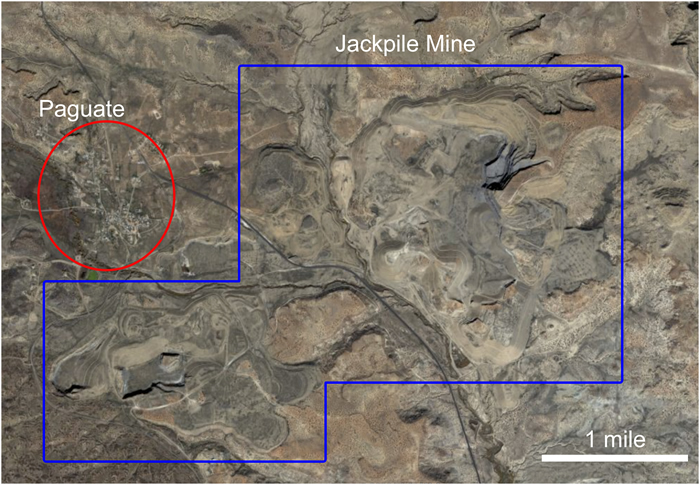
Uranium Legacy Issues In New Mexico
Environmental Issues

-
Most environmental concerns are associated with mining and milling sites, but the same concerns should be considered for natural near surface occurrences of uranium. We need to be concerned about all sources of uranium in the environment.
-
Because there was no regulatory framework in place during the earlier (pre-1990's) round of uranium mining, the New Mexico has been left with a legacy of environmental contamination from these activities.
-
Remediation is very costly, especially when groundwater cleanup is involved.
-
Many past efforts have been ineffective in limiting the risks to the environment and surrounding populations. For example, putting a few inches to feet of clean soil over contaminated rock or tailings may help limit the airborne risks (if the site becomes vegetated), but it does not limit the potential for groundwater contamination. More effective, integrated remediation plans have to be developed.
-
To date, two New Mexican uranium mills have been remediated. The Phillips Uranium Mill in Ambrosia Lakes cost $40 million to remediate 3.1 million tons of tailings, the Shiprock Mill cost $25 million to remediate 1.7 million tons of tailings, and Homestake Mill with its 22 million tons of tailings to remediate and the groundwater issues will probably far exceed the $56 million suggested by the NRC. There are many sites in New Mexico that require significant remediation. These include areas that may already have had some remediation such as Jackpile Mine and surrounding mines.
-
Many companies walked away from previous mining sites when the price of uranium dropped to $9.00/lb leaving an environmental cleanup problem for the state and federal government. This will require a very large sum of money, possibly into the billions. Where will these funds come from?
-
Are there some innovative ways to create funding for cleanup? Can we depend on finding past owners to do the cleanup? Or do we at some point have to “bite the bullet” about reclaimation? For example,
-
If the groundwater already contains dissolved uranium can groundwaters be pumped groundwaters without adding chemicals or oxygen that might affect the aquifer, and pass the waters through ISR-style ion exchange pellets. The recovered uranium could be sold to cover all or part of the costs of producing clean water for the surrounding communities.
-
As the federal government sells off ex-military uranium mined in New Mexico, should a portion of the proceeds go to remediate legacy issues?
-
Health
-
Not enough health studies have been done on the affected population in the area. In part, this due to the size of the population and the number of variables that could be causing health problems.
-
Inhalation of radon is the major cause of lung cancers.
-
Even natural, residential radon exposure has been linked to lung cancers (10% of all lung cancers in smokers and 30% of lung cancer deaths in non-smokers).
-
Non-smoking miners have a 100 X greater chance of getting lung cancer than the rest of the population. Miners who smoke have been shown to be at higher risk of developing cancers than non-smoking miners. Diesel fuel exhaust (truck drivers) also appear to increase the risks.
-
28% of 59,000 German U miners died of radon-induced lung cancers. Smoking, dust and arsenic may also play a role in increasing risks.
-
Uranium is toxic to kidney cells since the kidneys filter out uranium. If the exposure is of limited time and amount, the damage usually naturally repaired, but long-term exposure and high concentrations can cause kidney failure.
-
Uranium has both radioactive and heavy metal toxicity.
-
Nuclear reactor accidents present a different set of health effects (thyroid cancers, leukemia and other cancers) due to the radiation exposure.
-
Other health issues may be specifically related to milling processes (e.g. high sulfate concentrations in water).
Links to More Information
Any mention or link regarding a product, organization, company, or trade name is for information only and does not imply endorsement by the Bureau of Geology, NMT, or the State of New Mexico (see more).
Environmental Effects of Uranium Mining
- Abandoned Uranium Mines on the Navajo Nation
- Uranium Mining and Milling Wastes: An Introduction
- Shiprock Mill Site
- Ambrosia Lakes Mill
- Bluewater Valley Downstream Alliance
- Living near the Homestake
- Uranium Mining and Indigenous People
- Poison Fire, Sacred Earth
- Environmental Justice for the Navajo: Uranium Mining in the Southwest
- Uranium and Radiation Education Outreach (UREO) in Navajo Nation
- Uranium Mining Fact Sheets
- Health and Environmental Impacts of Uranium Contamination in the Navajo Nation
- Southwest Research and Information Center
- New uranium mining approaches in Hungary
- IAEA Publications
- The Carlsbad Environmental Monitoring & Research Center
Health Effects
- Uranium Health Effects
- Chernobyl disaster effects
- Radon Individual Dose Calculator
- Uranium Radiation Individual Dose Calculator
- Uranium Miner Health Risk Calculator
- Radiation Exposure for Uranium Industry Workers
- Health Hazards for Uranium Mine and Mill Workers - Science Issues
- Uranium Mine and Mill Workers - Current Issues
- Justice Department's Radiation Exposure Compensation Program
- Navajo Uranium Miners Fight for Compensation
- Radiation Exposure Screening & Education
- Human Radiation Experiments
- Native American Cancer Research Partnership
- CDC
- CDC: Radiation Emergencies
- ATSDR: Radon
- ATSDR: Uranium
- DOE's Comprehensive Epidemiologic Data Resource (CEDR)
- Radon and Cancer: Questions and Answers
- Occupational Safety in Uranium Mining
- Renal effects of uranium in drinking water
- "Yellow Monster"


